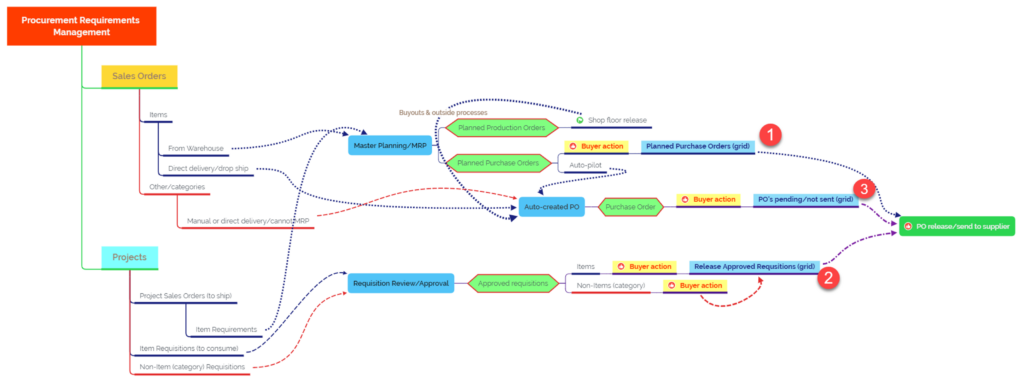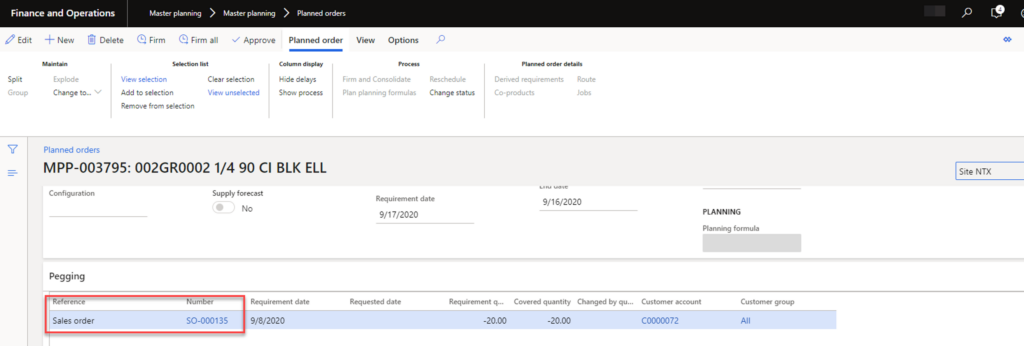Boss, I think they’ve got us surrounded
Procurement is often challenging enough in conventional supply chain organizations, but in organizations that are primarily project-oriented, this challenge is amplified. Many items are one-offs exclusive to the project. Many materials bypass the receiving dock and ship directly to the job site. The requests can come in many different formats—requisitions, item requirements, etc. In a typical project-oriented environment, with some minimal in-house production, material requirements might come via:
- Sales order–item shipment from stock
- Sales order—item direct ship from vendor
- Sales order—non-item/category
- Project item requirements
- Project purchase requisition—item
- Project purchase requisition—category or service, subcontract etc.
- Production-material requirement
- Production-outside services
- Production-direct purchase (purchase to order/buyout)
- Internal/employee requisitions
- Internal/supplier catalog requisitions
It seems as though on one side of the map we have a Persian army of requirements poised to overwhelm our lonely Greek purchasing manager Leonidas and his relatively tiny army of buyers, with the survival of our project reliant on preventing even a single requirement to slip through unfulfilled. OK, that might be just a bit of a hyperbole, but it does provide an opportunity to slip in a nifty strategy Leonidas deployed that helped his army of 7000 hold off Xerxes’ roughly 150,000 for more than a week at the Battle of Thermopylae. It’s also the same strategy you’ve seen in every old western involving an ambush. If you can focus on where the pathway narrows, you can battle the larger army on more even terms, and thankfully Microsoft Dynamics 365 offers some terrific procurement support tools, so you’ll hopefully have a better outcome than Leonidas .
The Three Pipes
The diagram below illustrates most of the sources of purchased requirements described above and their basic flow through the procurement process. Notice that while they may come from a dozen or more sources, taking many different paths to land on the buyer’s to-do list(s), they eventually all end up at the same result—a purchase order—and the buyer can catch all potential sources by monitoring just three points where the paths consolidate. Those paths are planned purchase orders, approved requisitions, and in rare instances, PO’s awaiting confirmation.
By monitoring those three pipes and using appropriate tools to efficiently process the requirements for each pipe, a single buyer may be able to stand up to the seemingly overwhelming volume and variety of requirements with relative ease. Let’s look at each of these pipes.
MRP Planned Requirements
Whether or not you think you need the full and potentially complex functionality of master planning, having it at least turned on and babysitting production and sales requirements, checking against inventory and orders, aligning dates, etc. is easy and can be a great helper. Not only does it identify what needs to be ordered, but by assigning due dates, and if lead times are known, order-by dates, it can help prioritize which unfulfilled requirements should be addressed first. The main benefits and tools available within this include:
- Review of planned purchase orders within a standard grid page, can be sorted, filtered, personalized, etc.
- Planned purchase orders can carry automatic vendor assignment for single-sourced items (set the default on released product record) or for multi-sourced items can select lowest price or shortest leadtime using trade agreements.
- Creating a PO from this screen is 2-click—select the record, then firm the order. Header, line, quantity, dates, etc. all are populated automatically.
- Selecting multiple lines and firming at once can follow grouping rules, such as single PO by vendor, etc.
- If blanket orders (purchase agreements) are in effect for any part, firming the planned purchase order will automatically release against the blanket rather than create a new order. Have you ever forgotten to check on blanket balances before creating a new PO?
- For parts you have high confidence in, all the above steps can be fully automated—zero eyeball or click time.
Note that this pipeline will capture all production material requirements, all non-project sales orders, and all project item requirements. For project requirements, though, the project is only on the demand side and MRP plans on covering the project through company owned inventory, purchase, etc. The purchase order itself would not be charged to the project or count towards committed cost (the project item requirement carries the committed cost). If the organization is not comfortable with this process and needs the PO itself to include the project, then instead of “firming” the planned orders, then the buyer could simply hyperlink from the planned order to the pegged item requirement (shows in the “reference” field, and from that sales order bring up the project to place a project PO, but that might be a bit too click-heavy for our overburdened buyer.
For a more efficient path, the buyer could just look directly at project item requirements grid page, personalized to add reference type and reference number, which will help sort out which item requirements are on order and which are blank/need to be ordered:
Note that using the item requirements bypasses MRP, so if there is available inventory or excess balance from another order, creating a PO from an item requirement will not apply that surplus. Also, the item requirement shows when the item is needed, but not taking leadtime into account, it does not indicate when the item needs to be ordered. Therefore, a more complete solution might be to allow MRP to plan/schedule purchase orders for project item requirements, but rather than firming those, use them as prompts to select those parts form item requirements grid and place them on project PO’s.
Approved Requisitions
There’s a standard grid page available via Procurement and sourcing > Purchase requisitions > Approved purchase requisition processing > Release approved purchase requisitions that displays all requisition lines that have been approved, but not placed on a PO yet. As with all grids, this includes sort/filter/personalize capability, and you can hyperlink to the requisition or item to find more information before ordering.
While processing these is roughly as easy as the MRP-planned purchases above—select the record(s) to order, then click “Purchase order” on the menu bar, depending on how much information was included on the requisition, there may be minor editing needed before ordering, such as assigning a vendor, verifying pricing, etc.
Depending on the volume of requisitions in your environment, there may also be benefit to using D365’s “consolidation opportunities” functionality. This is designed to suggest or automate combining requisitions for the same part or vendor to achieve volume discounts, reduce number of orders, etc.
Automated PO’s
There is an infrequently used process where a purchase order might be automatically or manually created by some process or person upstream, but which may need to buyer to finish off, validate, confirm with vendor, etc. Examples of this might be for outside processing operations on a production order where the BOM line automatically orders a “service” item when production is released, or where a sales order is configured for drop ship/direct delivery. In these cases, the best practice is for the PO to be in an unconfirmed status. To monitor this pipe, then, use the grid page Procurement and sourcing > Purchase orders > Purchase order entry > Purchase orders not sent. This will list those automatically generated PO’s, as well as any other PO’s that a buyer has forgotten to “confirm”, which may eventually cause receiving/vouchering problems if not corrected.
Processing through this pipe is another 2-click effort—click-select the records to finish off, then on the menu bar click “confirm”. Depending on your print/email configuration to send PO’s to vendors, you would then send the order as applicable. Note that “confirm” in D365 indicates that the buyer has finalized and sent the order, not to be confused with a vendor’s acknowledgement, which is generally reflected by populating the “confirmed delivery date” field on a PO line.
Conclusion
Trying to identify and react to the dizzying variety of requirements for materials, services, projects, sales, production, etc. is no easy task. That variety does, though, eventually show up into one of (3) common grids that can be easily searched, filtered and personalized, and within each of those grids, creating the PO is just a couple clicks to finish. By focusing on those main grids and using the efficiency tools built into them, you’ll have a much better grasp of what’s needed, relative priorities, and the information necessary to act upon those requirements. The pipes and the basic actions are:
- MRP planned purchases, “firm” and “confirm”. If MRP is not being used and project materials are tracked using item requirements instead, then the Item Requirements grid page, personalized and filtered for blank reference type can show all project requirements without matching project purchase orders (ignores MRP-planned PO’s to inventory that could apply to the project)
- Approved requisitions—“Release Approved Requisitions” grid to view requisitions approved but not yet ordered. Click to select, then New/Purchase Order and Confirm.
- PO’s automatically created, to review/send—“Purchase orders not sent” grid displays all PO’s that have not been “confirmed”. Depending on the reliability of the process used to automatically create the PO(s), review/scrub before sending, then “Confirm”.
About Chan Stevens:
Chan is a Senior Supply Chain and Projects Consultant for implementations of Microsoft Dynamics 365 solutions. Over the course of a 25+ year career his experience is evenly split between the client/user side and the software provider side. He has extensive experience as a manufacturing consultant, implementation manager and product design for Microsoft Gold partner’s ERP/CRM vertical solutions for engineered and/or project-oriented manufacturing, product configurator, and sales portal.




